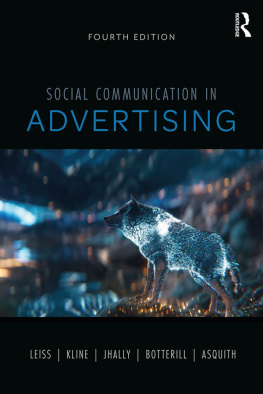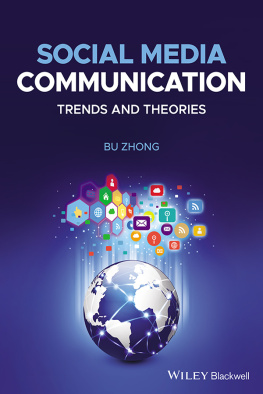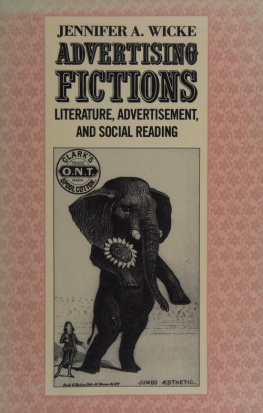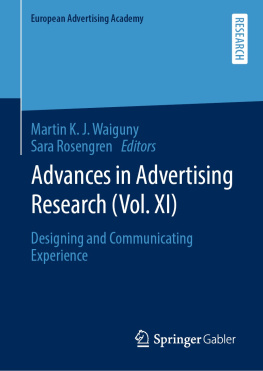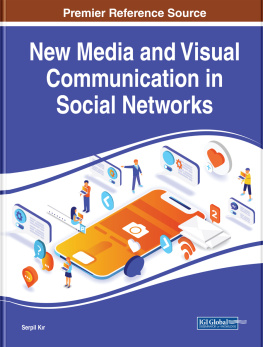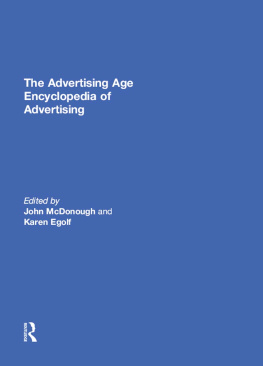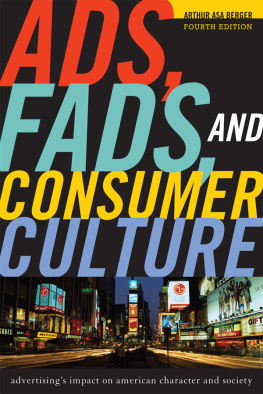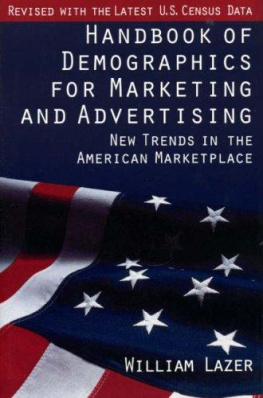Social Communication in Advertising
Newly updated for the digital era, this classic textbook provides a comprehensive historical study of advertising and its function within contemporary society by tracing advertisings influence throughout different media and cultural periods, from early magazines through social media. With several new chapters on the rise of the internet, mobile technology, and social media, this fourth edition offers new insights into the role of Google, Facebook, Snapchat, and YouTube as both media and advertising companies, as well as examining the role of brand culture in the twenty-first century.
William Leiss is Professor Emeritus at Queens University, Ontario, Canada, and Research Associate, McLaughlin Centre, University of Ottawa, Canada.
Stephen Kline is Professor Emeritus in the School of Communication at Simon Fraser University, Canada.
Sut Jhally is Professor of Communication at the University of Massachusetts, USA, and Founder and Executive Director of the Media Education Foundation.
Jacqueline Botterill is an Associate Professor in Communication at Brock University, Canada, where she teaches and researches in the areas of promotional and consumer culture.
Kyle Asquith is an Associate Professor in the Department of Communication, Media and Film at the University of Windsor, Canada.
Social Communication in Advertising
Fourth Edition
William Leiss
Stephen Kline
Sut Jhally
Jacqueline Botterill
Kyle Asquith
Fourth edition revised by Kyle Asquith
Fourth edition published 2018
by Routledge
711 Third Avenue, New York, NY 10017
and by Routledge
2 Park Square, Milton Park, Abingdon, Oxon OX14 4RN
Routledge is an imprint of the Taylor & Francis Group, an informa business
2018 Taylor & Francis
The right of William Leiss, Stephen Kline, Sut Jhally, Jacqueline Botterill and Kyle Asquith to be identified as the authors of this work has been asserted by them in accordance with sections 77 and 78 of the Copyright, Designs and Patents Act 1988.
All rights reserved. No part of this book may be reprinted or reproduced or utilized in any form or by any electronic, mechanical, or other means, now known or hereafter invented, including photocopying and recording, or in any information storage or retrieval system, without permission in writing from the publishers.
Trademark notice: Product or corporate names may be trademarks or registered trademarks, and are used only for identification and explanation without intent to infringe.
First edition published 1986 by Methuen
Third edition published 2005 by Routledge
Library of Congress Cataloging-in-Publication Data
Names: Leiss, William, 1939 author. | Kline, Stephen, author. | Jhally, Sut, author.
Title: Social communication in advertising / William Leiss, Stephen Kline, Sut Jhally, Jacqueline Botterill, Kyle Asquith.
Description: Fourth Edition. | New York : Routledge, 2018. | Revised edition of Social communication in advertising, 2005. | Includes bibliographical references and index.
Identifiers: LCCN 2017060141 | ISBN 9781138094550 (hardback) | ISBN 9781138094567 (pbk.) | ISBN 9781315106021 (eBook)
Subjects: LCSH: AdvertisingSocial aspects.
Classification: LCC HF5827 .S63 2018 | DDC 659.1/042dc23
LC record available at https://lccn.loc.gov/2017060141
ISBN: 978-1-138-09455-0 (hbk)
ISBN: 978-1-138-09456-7 (pbk)
ISBN: 978-1-315-10602-1 (ebk)
Typeset in Interstate Light
by Apex CoVantage, LLC
The original three authors began the research for what became the first edition of this book, published in 1986, about thirty-five years ago. At that time, the academic study of advertising was still largely confined to the fields of marketing, economics, and consumer behavior. To be sure, there was a semi-popular literature as well, which was usually highly critical of the contents of advertisements, but its coverage of the topic was haphazard, for the most part: One got the distinct impression that the authors of such works found the details of the material they were criticizing to be distasteful, to say the least, and thus intrinsically unworthy of serious analysis. All this began to change in the 1980s, as a cohort of scholars and writers began to take an entirely new and in-depth look at the subject of advertising.
Historians, sociologists, business-school professors, social theorists, psychologists, and communications researchers entered the fray in increasing numbers, bringing a spate of entirely new perspectives and research methods to bear on this subject matter. The serious study of advertising was thoroughly transformed in the process. This new generation of commentators opened up the wide vistas of history and culture, on the one hand, and entered deep into the physiognomy of individual advertisementsthe structure of their aesthetic design, persuasive techniques, and specific representations of persons and goodson the other. Much of this literature is referenced in the chapters that follow. But if we were asked to single out one title from this era, one contribution that best pointed the way to a new appreciation of its subject, it would be the marvelous book written by the historian Roland Marchand, Advertising the American Dream, published in 1985a work by an author whose insight, sophistication, and breadth of view set a high standard for everyone else who would venture into this territory.
Our own approach in this book has been based on a communications perspective, as the title indicates. We maintain that, beginning at the turn of the twentieth century, and continuing down through the turn of the twenty-first century, modern advertising has been responsible for nothing short of a revolutionary transformation in the techniques of persuasive communication. Designed initially for the selling of goods, in the era in which the mass consumer markets were being born, advertising practice developed over time an increasingly sophisticated view about how social communication works. Now, today, that understanding is used to market not just consumer goods, but also to construct dialogues in society involving complex ideaspolitical messages, advocacy by environmental groups and large corporations, people trying to change social values, those trying to influence lifestyle choices, and many others. Over a century of continuous development, and moving closely in step with regular innovations in communications technologies, advertisers taught all of us how rich, diverse, and simply fascinating are the ways in which a message can be conveyed.
For this has been, without a doubt, a process of educating our sensibilities. This point can be illustrated by comparing two ad formats, one from around 1900 and another from a century later. In , the reader will find a discussion of the communicative format of the old Sears catalogue, which remained a venerable institution, especially in rural areas, throughout the entire first half of the twentieth century. An illustration, taken from the 1908 edition, accompanies this discussion, showing the complete reliance on a print-based form of expression, relieved only by stylized drawings; the target audience was expected to digest a truly immense quantity of words in order to get the message. Contrast this with the extraordinary British tobacco ad campaign of the early 1990s by the brand Silk Cut, which relied entirely on pure visual imagery, with no words whatsoever, for its message strategy. The imagery, showing a bolt of purple silk (purple was the brands signature color) being cut by huge scissors, or patched with a band-aid after having been cut, had no accompanying text in the body of the ad itself. Rather, the ad designer was relying on the government anti-tobacco health message, required by law to be printed along the bottom panel of the layout, to trigger the readers set of mental associations and thus to release the promotional meaning for the product! An entire century of consumer experience with new communicative formats and strategiesresearched, planned, and designed by ad agency personnel, and implemented in a series of discrete stageswas required in order for anyone to be able to understand what those Silk Cut ads were about.


